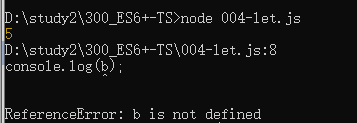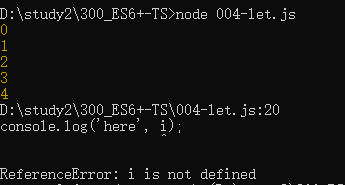ES6--let关键字
1.let关键字声明的变量,只在块中有效
if(true){
var a = 5;
let b = 5;
}
console.log(a);
console.log(b);
================分割线================
运行结果:

2.let关键字可以防止循环变量的泄露,同时能够提供闭包
for(let i = 0; i < 5; i++){
console.log(i);
}
console.log('here', i);
================分割线================
运行结果:

如果去掉最后一行,即:
for(let i = 0; i < 5; i++){
console.log(i);
}
================分割线================
运行结果:

3.let不会进行变量提升
console.log(a);
let a = 5;

4.暂时性死区:
let不进行变量提升,他会绑定到一个块作用域上;
变量提升:var 在预编译时将变量产生,只是数值没有初始化,所以可以访问;
绑定:let 在预编译时变量产生,但是在let声明之前,不允许使用,从块作用域的头部到let声明之间的范围(暂时性死区 TDS)
let b = 5;
if(true){
console.log(b);
// TDS
let b;
//undefined
b = 3;
// 3
}
5.let 不允许在同一个作用域内重复定义
{
let b = 5;
let b = 3;
console.log(b);
}

6.let声明的变量:内层可以访问外层的变量,外层不能访问内层的变量
let a = 5;
{
console.log(a);
}

{
let b = 4;
console.log(b);
}

{
let b = 4;
}
console.log(b);

// 7.块级作用域中的函数声明
// ES5:不允许在块结构中声明函数的
// ES6:1.允许在块结构中声明函数的
// 2.函数依然有预编译,函数名会提升到全局作用域或者函数作用域的头部
// 3.如果在块级作用域,会提升到块的头部
function f() {
console.log('outside!');
}
(function () {
if(false) {
function f() {
console.log('inside!');
}
}
f();
})();
===========ES5中运行结果===========

============ES6中运行结果===========





 浙公网安备 33010602011771号
浙公网安备 33010602011771号